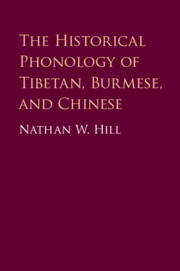Book contents
- The Historical Phonology of Tibetan, Burmese, and Chinese
- The Historical Phonology of Tibetan, Burmese, and Chinese
- Copyright page
- Dedication
- Epigraph
- Contents
- Figures
- Note on Abbreviations and Conventions
- Book part
- Introduction
- 1 Tibetan
- 2 Burmese
- 3 Chinese
- 4 Trans-Himalayan
- Appendix: Complete Lists of Examples
- References
- Index Verborum
- Index Rerum et Nomum
- Index Legum
1 - Tibetan
Published online by Cambridge University Press: 22 July 2019
- The Historical Phonology of Tibetan, Burmese, and Chinese
- The Historical Phonology of Tibetan, Burmese, and Chinese
- Copyright page
- Dedication
- Epigraph
- Contents
- Figures
- Note on Abbreviations and Conventions
- Book part
- Introduction
- 1 Tibetan
- 2 Burmese
- 3 Chinese
- 4 Trans-Himalayan
- Appendix: Complete Lists of Examples
- References
- Index Verborum
- Index Rerum et Nomum
- Index Legum
Summary
§1. Tibetan originated as the language spoken in the Yarlung valley, the cradle of the Tibetan empire (Takeuchi 2012a: 4). Together with the troops of this empire the Old Tibetan language colonized the entire Tibetan plateau, extinguishing almost all of the languages formerly spoken across that territory (Takeuchi 2012a: 6). Evidence is available for three such languages. Most famous is Źaṅ-źuṅ, the language of a pre-existing polity in West Tibet and the sacred tongue of the Bon faith. Źaṅ-źuṅ is preserved in one bilingual cosmological text, the Mdzod phug, and a number of short passages in Bon texts (cf. Martin 2010). The closest living relative of Źaṅ-źuṅ is the Darma language of Uttarakhand state in India (Martin 2010: 17–21, 2013). Aside from Źaṅ-źuṅ, samples of two Trans-Himalayan languages are preserved among the collection of documents found at Dunhuang. F. W. Thomas, who first published the manuscripts containing these two languages, confusingly dubs them ‘Źaṅ-źuṅ’ (Thomas 2011) and ‘Nam’ (Thomas 1948); there is no evidence to accept these identifications (Martin 2010: 10, 2013).
- Type
- Chapter
- Information
- Publisher: Cambridge University PressPrint publication year: 2019

